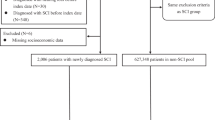Abstract
Study design: Inception cohort.
Objectives: The clinical impression that earwax is uncommonly frequent among spinal cord injury patients with high levels of paralysis was tested.
Setting: Veterans Administration Hospital, USA.
Methods: A cohort of 15 chronically paralyzed patients, motor complete, living as residents in a long-term care facility was offered monthly irrigations of the ears for removal of wax over a 6-month period. The number of requests was tabulated. All ears were examined once on a single day to determine point prevalence. The accumulated wax graded as absent or small, moderate or large.
Results: Two patients with C2 lesions, aged 37 and 52 years and paralyzed 15 and 16 years, were compared with 13 patients at C4–T6 aged 44–78 years, median 62 years, and paralyzed 2–33 years, median 24 years.
Over a 6-month observation period, 10 irrigations were requested by the C2 patients and three by the C4–T6 patients. The reasons were hearing loss. Wax was found and removed, and symptoms were relieved in all instances, P<0.001. The spot survey revealed earwax of moderate or large amounts in four of four C2 patient ears and in two of 24 C4–T6 patient ears, P=0.001.
Conclusion: Patients with C2 tetraplegia accumulate more earwax and request its removal more often than patients with lower levels of paralysis.
Similar content being viewed by others
Methods
During a tour of duty at a long-term health-care facility for spinal cord injured patients, monthly irrigations of the ears for wax control were offered to all patients. There were 15 patients, all with motor complete paralysis. These were divided, in retrospect, into Groups A and B. Group A consisted of two patients with C2 lesions, 37 and 52 years of age, and paralyzed 15 and 16 years. Group B consisted of 13 patients with lesions at C4–T6, median C6, aged 44–78 years, median 62 years, and paralyzed 2–33 years, median 24 years. The number of monthly irrigations requested by the patients in each group was recorded.
After the 6-month survey, the patients were examined for earwax on a single occasion just prior to the next scheduled monthly irrigation. The accumulation of wax was graded as 1 for absent or small amounts and as 2 for moderate to large (occluding) amounts. The prevalences of Grades 1 and 2 were tabulated for Groups A and B.
Groups A and B were compared for the number of requested treatments of earwax by χ2 analysis. The groups were also compared for the prevalence of earwax by the Fisher exact test. The software Primer of Biostatistics was used for all calculations.3
Results
The patients requesting irrigations did so with the complaint of hearing loss usually and discomfort occasionally. Otoscopic exam revealed earwax in all such instances. The amount of wax removed varied from voluminous casts of the ear canal to small chips. A few cases of earwax were inspissated. Group A patients required removal of earwax considerably more frequently than Group B, see Table 1. The prevalence for Grade 2 earwax accumulation was four of four ears in Group A and two of 24 ears examined in Group B (one of the Group B patients had died), P=0.001.
Discussion
The greater earwax accumulation in the C2 patients could not be correlated with older age or greater duration of paralysis. But dysreflexia, although not quantified in this cohort, was conceivably a factor. Sweating of the face is a component of the dysreflexic reaction4 that occurs frequently – daily or several times a day – in some individuals with SCI. The sebaceous and the modified sudoriferous glands of the ear canals that together produce cerumen and are responsive to noradrenaline5 may participate, it is suggested, in dysreflexic sweating. Alternately, facial blood flow, and conceivably wax production, may be increased with the patient lying supine because of the impaired defense of the circulation against gravity.6,7 Serial comparisons between severity of paralysis and position, facial blood flow, blood pressure, sweating, and cerumen accumulation would be required to test these suggestions.
On a therapeutic note, the flushing out of earwax with water after treatment with heavy mineral oil overnight was generally effective. Interestingly, water has been shown to disperse wax better than a variety of commercial oils in vitro.8
Conclusion
Regardless of explanation, it can be concluded that earwax, a frequent cause of hearing loss, is a common complication of high tetraplegia, motor complete.
References
Roeser RJ, Ballachanda BB . Physiology, pathophysiology, and anthropology/epidemiology of human ear canal secretions. J Am Acad Audiol 1997; 8: 391–400.
Petrakis NL, Wiesenfeld SL, Flander L . Possible influence of age on the expression of the heterozygous cerumen phenotype. Am J Phys Anthropol 1986; 69: 437–470.
Glantz SA . Primer of Biostatistics. 4th edn. McGraw-Hill: New York, NY 1997.
Head H, Riddoch G . The autonomic bladder, excessive sweating and some other reflex conditions in gross injuries of the spinal cord. Brain 1917; 40: 188–263.
Bende M . Human ceruminous gland innervation. J Laryngol Otol 1981; 95: 11–15.
Silver JR . Circulatory reflexes in spinal man. Paraplegia 1965; 2: 235–246.
Mathias CJ, et al. Plasma catecholamines, plasma renin activity and plasma aldosterone in tetraplegic man, horizontal and tilted. Clin Sci Mol Med 1975; 49: 291–299.
Andaz C, Whittet HB . An in vitro study to determine efficacy of different wax-dispersing agents. J Otol Rhinol Laryngol 1993; 55: 97–99.
Author information
Authors and Affiliations
Rights and permissions
About this article
Cite this article
Frisbie, J., Zahn, E. Earwax and level of paralysis. Spinal Cord 41, 247–248 (2003). https://doi.org/10.1038/sj.sc.3101444
Published:
Issue Date:
DOI: https://doi.org/10.1038/sj.sc.3101444



